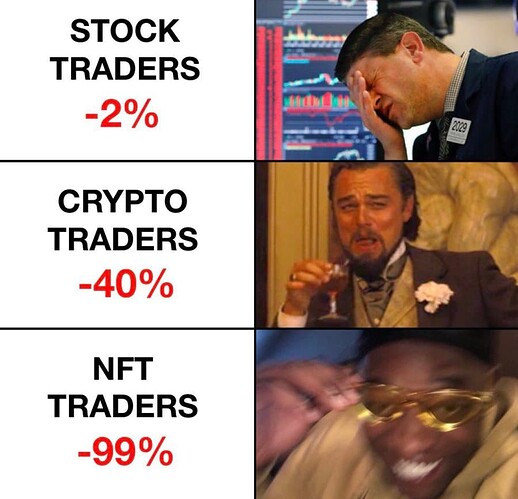If you added “-Labs” to the end of your name you really knew what you were talking about
Central to the effort is an eye-scanning physical “orb,” which Worldcoin’s founders say is necessary for a future in which distinguishing between humans and robots becomes increasingly challenging due to a surge in artificial intelligence technology. Once users have proven they are not robots, they can be issued one of the company’s tokens.
So a friend of mine accidentally sent $270K USD to the wrong Ethereum address. Whoops!

Click a mouse and lose a house.

Tell them chin up, traditional banks can do the same thing with Zelle.
What are the chances the address isn’t even used and the money just sits there forever?
Probably pretty high, i better check some of mine
Unlikely he sent it to a random address that is valid. More likely he sent it to the wrong address he used before. The recipient might not realise he got rich though.
Zero, he got scammed by this:
He is the richest person I know and 270K USD is in the “annoying” category for him, so well played to the scammer I guess.
So the “explain it to me like I was 5” version is this?
- Victim sends money to a legit address.
- Hacker sees this transaction on the blockchain, sends a $0 transaction from victim’s wallet (which is somehow allowed due to shitty code) to a very similar looking address.
- Victim sees the scam address in their history, which looks very similar to the one they’ve sent money to in the past, copies it, and sends money to the scam address.
Is that about right?
Yeah. To be fair to the people who wrote these token contracts, it would take up expensive blockchain storage space to store both isAllowedToTransfer and allowedAmount, and “nobody is going to pay transaction fees to transfer zero of a token” sounds like it makes sense when you don’t factor in this scamming plan. Which it took years to come up with and which is easily foiled now by user interfaces which flag zero-amount transfers as suspicious. That article is from February, I assume Trezor Suite have updated their interface by now, but probably my friend hadn’t bothered to update.
The contract solution could be done cheaply by inserting
require(_value > 0);
But it’s a totally obscure attack vector that probably won’t work well now that it is public and still requires the victim to really fuck up.
All things being equal, I’d prefer people not to be able to make public $0 transfers from my bank or Paypal account to some other random account.
It’s been too long since I’ve quoted Matt Levine without adding anything of my own:
Here is an economic system, or a system anyway:
- I make up a crypto token called MattCoin. I can issue an unlimited amount of MattCoins, since I made them up.
- I sell them to people for money.
- You can use MattCoins to make term deposits, with me: You can give me back your MattCoins and I will keep them for some specified time period (say, a year), and at the end of the period I will hand them back to you with interest.
- The interest is paid in MattCoins.
- The interest rate is high, say, 38% per year.
- This is the only thing you can do with the MattCoins. They’re not useful for payments, they don’t run smart contracts on a blockchain, all you can do is trade them on crypto exchanges and deposit them for a 38% yield paid in kind.
So you pay me $100 for 100 MattCoins, you deposit them with me for a year, and at the end of the year I give you back 138 MattCoins.
At the end of the year, how much would you expect your 138 MattCoins to be worth? I think the main options are [1] :
- $138. You put in $100 for 100 MattCoins, meaning that they are worth $1 each, and in a year you get back 138 MattCoins. If they are still worth $1 each, then 138 MattCoins are worth $138.
- $100. You put in $100 for some MattCoins, absolutely no economic activity happened , and in a year you get back 138 MattCoins. This is like a stock split: You had 100 shares of a pot worth $100, now you have 138 shares of a pot worth $100, each share is worth less but the pot hasn’t changed.
- $0. You put in $100 for some MattCoins, absolutely no economic activity happened or will ever happen , in a year you get back 138 MattCoins, but I keep the $100 and you don’t get to exchange your 138 MattCoins for real money again. There is not actually a pot with $100 in it; I just took the $100! You put in $100 and got back a pile of magic beans that are not redeemable for anything. The pile grew bigger over the year, but it remains worthless.
- More than $138. You put in $100 for 100 MattCoins, those MattCoins offered a 38% yield, other people see that 38% yield and said “I want some of that,” they buy some MattCoins, the price of MattCoin rises, still other people see the rising price and say “ooh I want some of that ,” the price rises further, it’s a virtuous cycle, eventually each MattCoin is worth like $10,000 and your 138 MattCoins make you a millionaire.
I think that Answer 3 is the standard answer that traditional financial analysis would give you: You bought an electronic token with no cash flows ever, so it’s worth zero. I am drawn to this traditional analysis, but it has not really worked all that well for understanding crypto.
I think that Answer 4 is the standard answer that crypto would give you . This is a completely accepted mechanism of crypto finance: You have some token, the main thing that the token does is generate more tokens, you call those additional tokens “yield,” people are attracted to the yield, they buy the token and its price goes up. The “yield” does not come from any economic activity in the real world ; it just comes from printing more tokens. “Ponzinomics,” people sometimes say. Loosely speaking, this is the thought process behind crypto “Ponzicoins” like OlympusDAO and Wonderland. Loosely speaking, it is the thought process behind many algorithmic stablecoins like TerraUSD. Loosely speaking, it is the thought process that Sam Bankman-Fried once described to me on Odd Lots: “You start with a company that builds a box and in practice this box, they probably dress it up to look like a life-changing, you know, world-altering protocol that’s gonna replace all the big banks in 38 days or whatever. Maybe for now actually ignore what it does or pretend it does literally nothing. It’s just a box.”
He goes on to talk about an SEC enforcement action against Hex, but I think the above is the purest distillation of crypto yield that I’ve seen.
That box analogy is still incredible
In this issue of the Bloomberg Crypto newsletter, Michael P. Regan takes a look at the laser eyes on the campaign trail.
The beauty contests for next year’s US presidential election are starting to heat up, which means so is the political rhetoric regarding cryptocurrencies. Yet unlike so many other big, polarizing topics in the US, opinions on crypto remain tough to pigeonhole entirely along party lines.
Regulators during President Joe Biden’s term obviously have not taken a friendly stance toward the industry by pursuing a variety of enforcement actions against digital-asset exchanges, executives and hucksters
. Ron DeSantis, the Republican governor of Florida, is staking out the opposing ground by promising at the Family Leadership Summit to end “Biden’s war on Bitcoin and cryptocurrency,” as well as any future Federal Reserve effort to reappropriate blockchain technology in the form of a central bank digital currency, if he is elected president.
However, while the top-polling Republican, former President Donald Trump, had a more hands-off approach than Biden’s while he was in office, he is on the record saying he’s “not a fan” of crypto and telling Fox Business in 2021 that Bitcoin “seems like a scam.” Of course, he was willing to accept crypto as payment for his non-fungible token collection featuring cartoon images of him in flattering poses.
…
Yet on the Democrat side, Robert Kennedy Jr.’s stance is perhaps the most extreme of all so far: He wants the US to start buying Bitcoin and other assets to underpin the value of the dollar, a notion that Newsweek says was swiftly “trashed” by experts.
Politicians love polls, and some may shed light on why the political lines are so blurry when it comes to digital assets: A survey last year by the Crypto Council for Innovation actually found that slightly more Democrats own crypto than Republicans - 13% versus 10%
- while 17% of independents said they were hodlers. None of those numbers scream that defending crypto is necessarily a “red meat for the base” - type of issue in a political campaign.
There’s another poll that candidates may want to consult before adding laser eyes to their official campaign headshot: A Pew Research Center survey conducted in March found that 75% of Americans who have heard of cryptocurrencies are not confident in their safety or reliability.
I think in most cases the answer is actually #3. Very very few crypto assets have held value over time and arguably they are the ones with some relative utility over the millions of worthless coins and tokens.
I can’t think of a straight yield scam token that hasn’t completely crashed and burned at this point.


